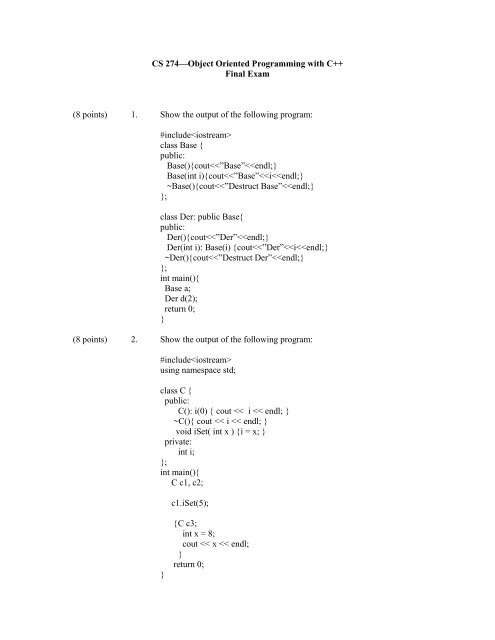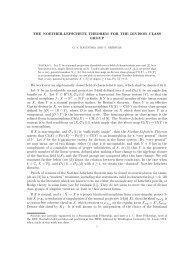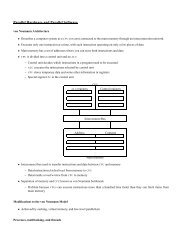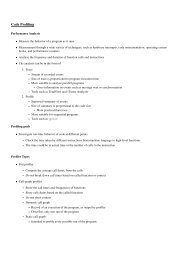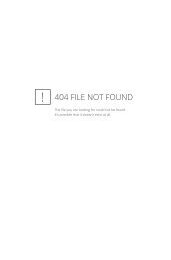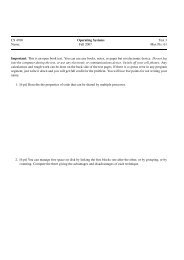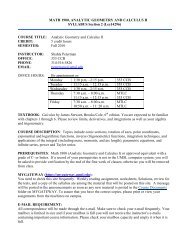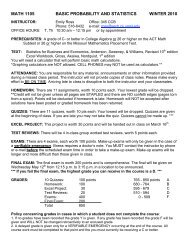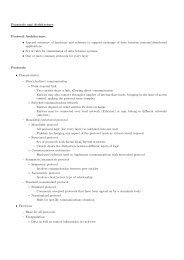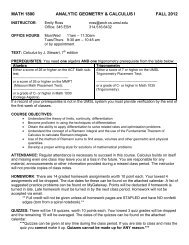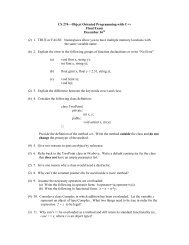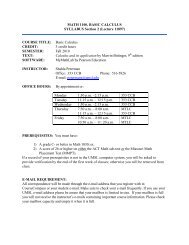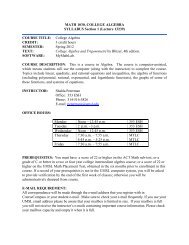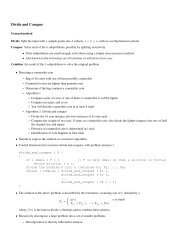CS 274âObject Oriented Programming with C++ Final Exam (8 ...
CS 274âObject Oriented Programming with C++ Final Exam (8 ...
CS 274âObject Oriented Programming with C++ Final Exam (8 ...
Create successful ePaper yourself
Turn your PDF publications into a flip-book with our unique Google optimized e-Paper software.
<strong>CS</strong> 274—Object <strong>Oriented</strong> <strong>Programming</strong> <strong>with</strong> <strong>C++</strong><br />
<strong>Final</strong> <strong>Exam</strong><br />
(8 points) 1. Show the output of the following program:<br />
#include<br />
class Base {<br />
public:<br />
Base(){cout
(8 points) 3. Show the output of the following program:<br />
#include<br />
class A{<br />
public:<br />
int f(){return 1;}<br />
virtual int g(){return 2;}<br />
};<br />
class B: public A{<br />
public:<br />
int f(){return 3;}<br />
virtual int g(){return 4;}<br />
};<br />
class C: public A{<br />
public:<br />
virtual int g(){return 5;}<br />
};<br />
int main(){<br />
A *pa;<br />
A a;<br />
B b;<br />
C c;<br />
pa=&a; cout
(8 points) 4. Show the output of the following program:<br />
#include<br />
class A{<br />
protected:<br />
int a;<br />
public:<br />
A(int x=1) {a=x;}<br />
void f(){a+=2;}<br />
virtual g(){a+=1;}<br />
int h() {f(); return a;}<br />
int j() {g(); return a;}<br />
};<br />
class B: public A{<br />
private:<br />
int b;<br />
public:<br />
B(){int y=5){b=y;}<br />
void f(){b+=10;}<br />
void j(){a+=3;}<br />
};<br />
int main(){<br />
A obj1;<br />
B obj2;<br />
cout
(10 points) 5. Circle TRUE or FALSE for each of the following statements:<br />
TRUE FALSE<br />
TRUE FALSE<br />
TRUE FALSE<br />
TRUE FALSE<br />
TRUE FALSE<br />
TRUE FALSE<br />
TRUE FALSE<br />
TRUE FALSE<br />
TRUE FALSE<br />
TRUE FALSE<br />
An abstract base class cannot be instanced.<br />
Pointers to a base class may be assigned the<br />
address of a derived class object.<br />
A pure virtual method must be overridden in a<br />
derived class.<br />
An abstract base class cannot have non-abstract<br />
derived classes.<br />
The assignment operator may be overloaded as a<br />
method.<br />
Polymorphic functions only exist outside of<br />
inheritance hierarchies.<br />
A derived class cannot have a method <strong>with</strong> the<br />
same name as a base class method.<br />
If a binary operator is overloaded using a toplevel<br />
function, then two parameters are required.<br />
A unary operator overloaded as a method still<br />
requires one parameter.<br />
A map is a sequential container.
(22 points) 6. Declare a class named Triple <strong>with</strong> three private data members (floats) x,<br />
y, and z. Provide public functions for setting and getting values of all the<br />
private data members. Define a constructor that initializes the values to<br />
user-specified values or, by default, sets the values all equal to 0. Also<br />
overload the following operators:<br />
—Addition so that corresponding elements are added together<br />
—Output so that it displays the Triple in the form “The triple is (x, y, z).”<br />
—Assignment that copies x to z, y to x, and z to y.<br />
—Post-increment so that x and z are increased by one each.<br />
—Function call operator so that the values for x, y and z can be set.
(22 points) 7. Write a program that has an abstract base class named Quad. This class<br />
should have four member data variables (floats) representing side lenghts<br />
and a pure virtual function Area. It should also have a method for setting<br />
the data variables. Derive a class Rectangle from Quad and override the<br />
Area method so that it returns the area of the Rectangle. Write a main<br />
function that creates a Rectangle and sets the side lengths. Also write a<br />
top-level function that will take a parameter of type Quad and return the<br />
value of the appropriate Area function.
(14 points) 8. Write a template class Point <strong>with</strong> two class parameters representing the<br />
two coordinates of the Point. Include public methods to display and set<br />
the data values as well as a function that swaps the values so that, after<br />
the swap, the first element becomes the second and the second becomes<br />
the first. Also write a main function that creates a Point object and calls<br />
the public methods.


